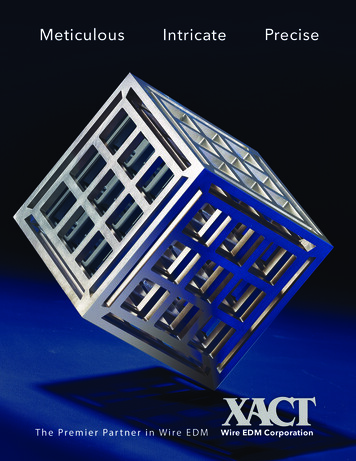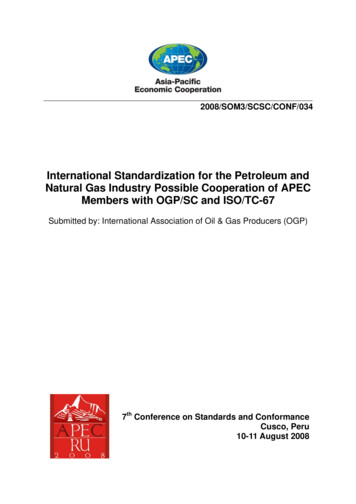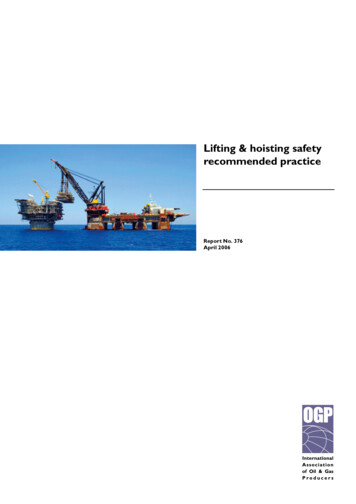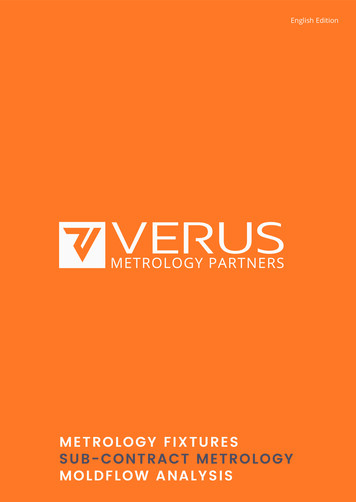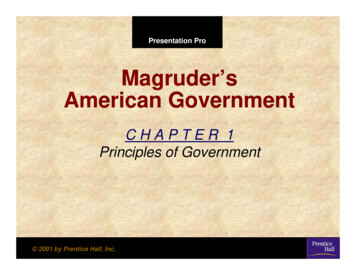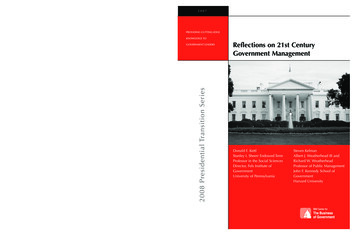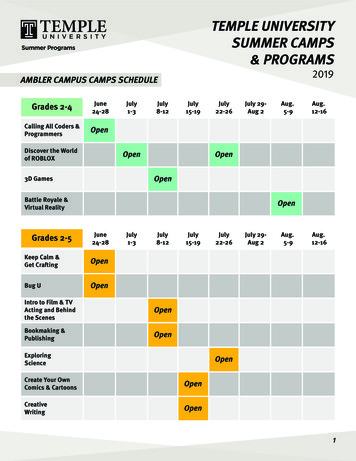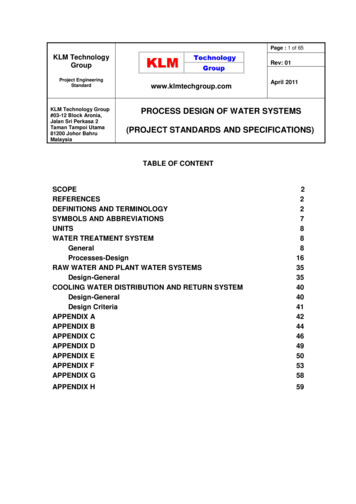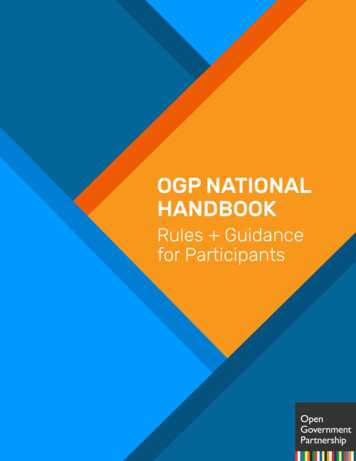
Transcription
OGP NATIONALHANDBOOKRules Guidancefor Participants
OGP National HandbookRules and Guidance for ParticipantsVersion 5.0 (Formerly OGP POC Manual)March 2022This work is licensed under the Creative Commons Attribution 4.0 International License. To view a copy ofthis license, visit http://creativecommons.org/licenses/by/4.0/ or send a letter to Creative Commons, PO Box1866, Mountain View, CA 94042, USA.OGP NATIONAL HANDBOOK1
Table of ContentsIntroduction . . . . . . . . . . . . . . . . . . . . . . . . . . . . . . . . . . . . . . . . . . . . . . . . . . . . . . . . . . . . . . . . . . . . . . . . . 41. Roles and Responsibilities: Key Actors and Stakeholders inOpen Government Partnership . . . . . . . . . . . . . . . . . . . . . . . . . . . . . . . . . . . . . . . . . . . . . . . . . . . . . . 51.1 The Multi-Stakeholder Forum or Platform . . . . . . . . . . . . . . . . . . . . . . . . . . . . . . . . . . . . . . . . . . . . . . . . . . . 61.1.a. Responsibilities of the MSF/P . . . . . . . . . . . . . . . . . . . . . . . . . . . . . . . . . . . . . . . . . . . . . . . . . . . . . . . . . . . . . 61.1.b. MSF/P Composition . . . . . . . . . . . . . . . . . . . . . . . . . . . . . . . . . . . . . . . . . . . . . . . . . . . . . . . . . . . . . . . . . . . . . . 71.1.c. Key Elements to Consider When Setting Up an MSF/P . . . . . . . . . . . . . . . . . . . . . . . . . . . . . . . . . . . . . . . . 71.2 Who Supports Country Stakeholders? . . . . . . . . . . . . . . . . . . . . . . . . . . . . . . . . . . . . . . . . . . . . . . . . . . . . . 82. The Co-Creation Process . . . . . . . . . . . . . . . . . . . . . . . . . . . . . . . . . . . . . . . . . . . . . . . . . . . . . . . . . 92.1 Key Moments in the Co-creation Process . . . . . . . . . . . . . . . . . . . . . . . . . . . . . . . . . . . . . . . . . . . . . . . . . . 92.1.a Planning for the Process . . . . . . . . . . . . . . . . . . . . . . . . . . . . . . . . . . . . . . . . . . . . . . . . . . . . . . . . . . . . . . . . . . 102.1.b Outreach . . . . . . . . . . . . . . . . . . . . . . . . . . . . . . . . . . . . . . . . . . . . . . . . . . . . . . . . . . . . . . . . . . . . . . . . . . . . . . . 122.1.c Action Plan Development . . . . . . . . . . . . . . . . . . . . . . . . . . . . . . . . . . . . . . . . . . . . . . . . . . . . . . . . . . . . . . . . . 132.1.d Feedback and Reasoned Response . . . . . . . . . . . . . . . . . . . . . . . . . . . . . . . . . . . . . . . . . . . . . . . . . . . . . . . 152.2 Submission of Action Plans to OGP . . . . . . . . . . . . . . . . . . . . . . . . . . . . . . . . . . . . . . . . . . . . . . . . . . . . . . . 162.3 Four-Year Rules Refresh . . . . . . . . . . . . . . . . . . . . . . . . . . . . . . . . . . . . . . . . . . . . . . . . . . . . . . . . . . . . . . . . . 163. Action Plan Rules and Templates . . . . . . . . . . . . . . . . . . . . . . . . . . . . . . . . . . . . . . . . . . . . . . . . . . . 173.1 Action Plan Timelines and Delivery Windows . . . . . . . . . . . . . . . . . . . . . . . . . . . . . . . . . . . . . . . . . . . . . . . 173.1.a Delays . . . . . . . . . . . . . . . . . . . . . . . . . . . . . . . . . . . . . . . . . . . . . . . . . . . . . . . . . . . . . . . . . . . . . . . . . . . . . . . . . . 183.1.b Political transitions and elections . . . . . . . . . . . . . . . . . . . . . . . . . . . . . . . . . . . . . . . . . . . . . . . . . . . . . . . . . . 193.2 Action Plan and Commitment Template . . . . . . . . . . . . . . . . . . . . . . . . . . . . . . . . . . . . . . . . . . . . . . . . . . . . 193.2.a Characteristics of a Good Action Plan . . . . . . . . . . . . . . . . . . . . . . . . . . . . . . . . . . . . . . . . . . . . . . . . . . . . . 193.2.b Action Plan Contents . . . . . . . . . . . . . . . . . . . . . . . . . . . . . . . . . . . . . . . . . . . . . . . . . . . . . . . . . . . . . . . . . . . . 213.2.c The Commitment Template . . . . . . . . . . . . . . . . . . . . . . . . . . . . . . . . . . . . . . . . . . . . . . . . . . . . . . . . . . . . . . 223.3 Self-Assessment Template . . . . . . . . . . . . . . . . . . . . . . . . . . . . . . . . . . . . . . . . . . . . . . . . . . . . . . . . . . . . . . 243.4 Challenge Commitments . . . . . . . . . . . . . . . . . . . . . . . . . . . . . . . . . . . . . . . . . . . . . . . . . . . . . . . . . . . . . . . . 274. Implementation . . . . . . . . . . . . . . . . . . . . . . . . . . . . . . . . . . . . . . . . . . . . . . . . . . . . . . . . . . . . . . . . . 274.1 Implementation Planning . . . . . . . . . . . . . . . . . . . . . . . . . . . . . . . . . . . . . . . . . . . . . . . . . . . . . . . . . . . . . . . . 284.2 Implementation Activities . . . . . . . . . . . . . . . . . . . . . . . . . . . . . . . . . . . . . . . . . . . . . . . . . . . . . . . . . . . . . . . 284.3 Monitoring . . . . . . . . . . . . . . . . . . . . . . . . . . . . . . . . . . . . . . . . . . . . . . . . . . . . . . . . . . . . . . . . . . . . . . . . . . . . 284.4 Assessments . . . . . . . . . . . . . . . . . . . . . . . . . . . . . . . . . . . . . . . . . . . . . . . . . . . . . . . . . . . . . . . . . . . . . . . . . . 295. Accountability and Information Provision . . . . . . . . . . . . . . . . . . . . . . . . . . . . . . . . . . . . . . . . . . . 295.1 National OGP Website . . . . . . . . . . . . . . . . . . . . . . . . . . . . . . . . . . . . . . . . . . . . . . . . . . . . . . . . . . . . . . . . . . 295.2 Document Repository . . . . . . . . . . . . . . . . . . . . . . . . . . . . . . . . . . . . . . . . . . . . . . . . . . . . . . . . . . . . . . . . . . 30OGP NATIONAL HANDBOOK2
5.3 Designing an Online Repository . . . . . . . . . . . . . . . . . . . . . . . . . . . . . . . . . . . . . . . . . . . . . . . . . . . . . . . . . .5.3.a Using your current OGP website . . . . . . . . . . . . . . . . . . . . . . . . . . . . . . . . . . . . . . . . . . . . . . . . . . . . .5.3.b Using Ready-made Tools . . . . . . . . . . . . . . . . . . . . . . . . . . . . . . . . . . . . . . . . . . . . . . . . . . . . . . . . . . .5.3.c Open-source Repositories . . . . . . . . . . . . . . . . . . . . . . . . . . . . . . . . . . . . . . . . . . . . . . . . . . . . . . . . . .313131316. Beyond the National Executive: Guidance on Participation ofOther Branches and Levels of Government . . . . . . . . . . . . . . . . . . . . . . . . . . . . . . . . . . . . . . . . . . . 326.1 Parliamentary Engagement . . . . . . . . . . . . . . . . . . . . . . . . . . . . . . . . . . . . . . . . . . . . . . . . . . . . . . . . . . . . . . 326.2 OGP Judiciary . . . . . . . . . . . . . . . . . . . . . . . . . . . . . . . . . . . . . . . . . . . . . . . . . . . . . . . . . . . . . . . . . . . . . . . . . 336.3 OGP Local . . . . . . . . . . . . . . . . . . . . . . . . . . . . . . . . . . . . . . . . . . . . . . . . . . . . . . . . . . . . . . . . . . . . . . . . . . . . 336.3.a Strategic Inclusion of Local Commitments within the National Action Plan . . . . . . . . . . . . . . . 336.3.b Minimum Requirements for Commitments by Local Governments in the action plan . . . . . . 346.3.c Inclusion of Local Open Government Efforts as Additional Initiatives in the action plan . . . . 346.3.d Knowledge and Learning . . . . . . . . . . . . . . . . . . . . . . . . . . . . . . . . . . . . . . . . . . . . . . . . . . . . . . . . . . 347. Minimum Participation Requirements and Acting Contrary to Process . . . . . . . . . . . . . . . . . . 35OGP NATIONAL HANDBOOK3
IntroductionThe Open Government Partnership (OGP) is based on the idea that an open government is more transparent,inclusive, participatory, and accountable to citizens and that improving the relationship between people and theirgovernment has long-term benefits for everyone. Collaboration between government, civil society, and otherstakeholders (e.g., citizens, local governments, parliament, academics, private sector, etc.) is at the heart of theOGP process.Research based on OGP data over the last ten years shows that a strong and inclusive co-creation process leadsto well-designed and more ambitious commitments. Research also shows that stronger results are achieved whencollaboration continues through the implementation of reforms. Public participation improves the quality of publicservices when everyone can speak and officials consider and respond to these views.The OGP National Handbook was designed to help reformers in government and civil society navigate the OGPprocess. It includes guidance, examples, best practices, templates, and information on minimum requirementsof all the key moments in a country’s participation in OGP. All content has been updated to reflect the new OGPParticipation and Co-creation Standards (see Box 1) which were designed to ensure that the rules are light touchand flexible, and lead to greater action plan ambition, inclusion, and relevance. Ultimately, the intent is to equipreformers with better guidance on how to use OGP to respond to their country’s most pressing societal challenges.This handbook consists of seven parts. Section 1 discusses the roles and responsibilities of key actors in theopen government process. Section 2 details the requirements in co-creation, while Section 3 outlines action planrules and required templates in co-creation. Section 4 focuses on implementation of the action plan, andSection 5 describes accountability processes and information provision. Section 6 provides guidance onother actors in open government beyond the executive department, more specifically the judiciary and localgovernments. Finally, Section 7 provides the minimum participation requirements and guidance for when countriesare considered acting contrary to process.Box 1. OGP Participation and Co-creation Standards (2021)Standard 1Establishing a space for ongoing dialogue and collaboration between government,civil society, and other non-governmental stakeholders.Standard 2Providing open, accessible and timely information about activities and progresswithin a member’s participation in OGP.Standard 3Providing inclusive and informed opportunities for public participation duringco-creation of the action plan.Standard 4Providing a reasoned response and ensuring ongoing dialogue between governmentand civil society and other non-governmental stakeholders as appropriate duringco-creation of the action plan.Standard 5Providing inclusive and informed opportunities for ongoing dialogue andcollaboration during implementation and monitoring of the action plan.OGP NATIONAL HANDBOOK4
1. Roles and Responsibilities: Key Actorsand Stakeholders in Open GovernmentPartnershipOGP is a broad partnership that includes members at the national and local level and thousands of civil societyorganizations. This unique model ensures that civil society organizations and other stakeholders have a role inshaping and overseeing governments. Governments are indispensable actors in the OGP process. Governments commit to upholding the principles ofopen and transparent government by endorsing the Open Government Declaration.Each government identifies a lead ministry or government agency that will assume the responsibility forcoordinating the government’s OGP process and activities and serve as the official contact point for thePartnership. The lead ministry or agency would ideally have oversight of matters related to good governanceand the ability to coordinate across ministries or government agencies in open government matters.The head of the chosen ministry or agency will be the ministerial-level point of contact for OGP. The governmentmust also appoint a working-level Point of Contact (POC). This person will be responsible for coordinating aparticipating government’s domestic and international OGP activities. The role is crucial and multidimensional,as POCs are at the forefront of open government efforts in an OGP country – engaging and conveningstakeholders on a regular basis and coordinating OGP initiatives to promote transparency, participation, andaccountability.The primary responsibilities and activities for the OGP Point of Contact include: Stakeholder engagement: Work with civil society and other stakeholders on an ongoing basis. Thisengagement includes the development and management of a multi-stakeholder forum (MSF) in cooperation withcivil society (see section 1.2), per OGP’s Participation and Co-Creation Standards. OGP Support Unit engagement: Work with the OGP Support Unit to assist in the action plan developmentprocess, assessing all available resources and identifying international best practices for potential localapplication. Government coordination: Work with other government agencies involved in relevant issues that emergeduring the co-creation and implementation process. Independent Reporting Mechanism (IRM) engagement: Activities include: Communicating with the IRM team and researchers, providing information and contacts to the IRM regardingOGP in the country, as well as providing comments during the review process of IRM reports. Assisting and facilitating the use of IRM reports to identify and address areas for improvement and toencourage adoption of IRM recommendations with OGP stakeholders in the country. Engaging with the IRM team and researchers in the uptake and dissemination of IRM findings, for example,participating in IRM events and collaborating to secure high-level participation. For more information on theIRM, please visit the IRM page on the OGP website or contact the team at: irm@opengovpartnership.org.OGP NATIONAL HANDBOOK5
Global and regional OGP event participation: This also requires informing senior government officials aboutOGP events and activities and facilitating their participation and encouraging high-level attendance at regionalevents and global summits. Peer exchange activities participation: Participation includes either providing support to colleagues orrequesting opportunities for collaboration and learning.Over the years, OGP participation has grown beyond the national executive branch, and some countries haveincluded the legislative and judiciary branches and diverse autonomous bodies and local governments in OGPprocesses. Members are encouraged to engage these bodies in their OGP process (see Section 6 for moreinformation.) Civil society organizations (CSO) are indispensable actors in the OGP process. Governments are required toengage with civil society toward a clear and open process of participation. Civil society may include communitygroups, non-governmental organizations, think tanks, advocacy groups, labor unions, indigenous groups,charitable organizations, faith-based organizations, professional associations, and foundations. CSOs are keypartners in the design, implementation, and monitoring of OGP action plans; participation in multi-stakeholdermechanisms; and awareness-raising among citizens about OGP and its achievements.Ongoing dialogue between government and civil society (and other stakeholders as appropriate) is a coreelement of OGP membership. This is critical to build relationships and trust, which can lead to increasedsustainability and ability to overcome challenges. In this case, the role of the Multi-Stakeholder Forum orPlatform is important. Other actors involved in the OGP process include: academia, the private sector, international organizations,and donors. They provide an enabling environment for open government processes to take root by providingtechnical assistance, expertise, financial resources, and support. In some cases, they also act as observers,monitors, and commentators, gauging the progress of open government initiatives in the country.1.1. The Multi-Stakeholder Forum or PlatformThe Multi-Stakeholder Forum or Platform1 (MSF/P) is an established space for ongoing dialogue and collaborationbetween government and civil society and leads the open government processes within a country.1.1.a. Responsibilities of the MSF/PWhile early MSFs focused on developing action plans, today they oversee implementation and engage withrelevant stakeholders to advance the open government process and communicate proactively about the progressof open government reforms in the country.Key responsibilities of the MSF/P include: 1Strategic and tactical planning. Based on available resources, priorities within and outside the government,and the political context, the MSF/P strategizes on the best ways to approach the development, implementation,and monitoring of action plans. It ensures that open government directions or aims are established, strategicthemes to be addressed in action plans and stakeholders are engaged in open government processes. As anestablished space, the MSF/P can also be used to respond to emerging priorities or opportunities.The platform can be an existing structure or platform, but what is important is it is consistent with what is discussed in Section 1.1.OGP NATIONAL HANDBOOK6
Engagement. The MSF/P proactively identifies ways to engage stakeholders from within and outsidegovernment on different open government processes within the country, including the development,implementation, and monitoring of the action plan. It also establishes avenues for other non-governmentalstakeholders, such as academia and the private sector to engage with the OGP process. The MSF/P alsoprovides opportunities for remote participation in some meetings and events to enable the inclusion of groupsunable to attend in person. Communication. The MSF/P undertakes activities to inform open government stakeholders and the broaderpublic about open government processes in the country and how they can participate. It also proactivelycommunicates and reports back on its activities, decisions, and results to government and civil societystakeholders. Oversight. The MSF/P oversees domestic processes related to OGP and ensures the development,implementation, and monitoring of action plans. It assesses action plan development and implementation andidentifies ways to approach these processes in future iterations. The MSF/P also coordinates cross-sectorefforts towards openness beyond the action plan.The MSF/P should develop mechanisms to coordinate and collaborate that include synchronous and asynchronousmechanisms. The meeting schedule should allow for coordination, particularly during busy moments in the OGPcycle, without becoming burdensome and unnecessarily bureaucratic. Rules on meeting frequency, membership,and decision-making processes should be published on the national OGP website.1.1.b. MSF/P CompositionThe MSF/platform comprises representatives from government and civil society. Its ultimate composition shouldconsider the following: Balance. The MSF/P should ensure that no constituency, government, or civil society is over- orunderrepresented. In consultation with civil society, the government point of contact defines and coordinatesthe participation of other government actors and other stakeholders in the MSF/P. Inclusion. The MSF/P should proactively include representatives of groups such as women, youth, seniors,people with disabilities, LGBTQIA and indigenous communities, or other historically underrepresented groupswho may have different needs or insights critical to shaping proposed government reforms. Diverse – It may be useful that the MSF/P represents a diverse set of stakeholders and interests. Conductinga diversity assessment may be useful in determining which groups or interests have or do not have access orinfluence over the MSF/P.21.1.c. Key Elements to Consider When Setting Up an MSF/PWhile there is no required framework for setting up and establishing an MSF/P, the following can be consideredduring the process:Government participants. It is important to have representatives from the ministries, departments, and/oragencies responsible for implementing open government policies, such as access to information agencies ande-government or telecommunications departments. It is also beneficial to include ministries with cross-governmentcoordination capacity, like the cabinet secretariat or the ministry for budget and management. In the latter stagesof the process, it is also useful to ensure the agencies that will implement the commitments included in the actionplan are involved and communicate with the MSF/P.2See Section 2 of Tool 1 in this OGP Toolkit for More Gender-Responsive Action Plans.OGP NATIONAL HANDBOOK7
Civil society participants. Civil society participants may select among themselves who will become members ofthe MSF/P. However, it is crucial that all civil society organizations are informed and given the space to participatein this process. A call for participation can be issued by an initial group of civil society organizations and circulatedwidely to invite both national and local civil society organizations. Those who express interest shall selectamong themselves who will become representatives to the MSF/P. While the self-selection process is OGP’srecommended approach, governments can play a role as long as the process is transparent and has clear rulesand criteria for selection, and the process is open to all civil society actors interested in participating.Other participants. In a number of OGP countries, representatives from other government branches or otherlevels of government, academia, or the private sector are included in the MSF, given their potential contributionsto the open government agenda in the country and roles they can play during co-creation and implementation. It isimportant that such representation does not replace the space for civil society participants in the forum.Size of the MSF/P. The number of representatives from both government and civil society should be sufficient tobe inclusive and reflect the key open government stakeholders in the country. At the same time, it should also belean enough to allow agility and efficiency in decision-making processes and MSF/P functioning. It is important tonote that a core function of the MSF/P is to engage stakeholders beyond the MSF/P in the action plan developmentand implementation process. The MSF/P does not reflect or represent the entirety of stakeholders important in theOGP process.Political support. Sufficient political support, especially from high-level officials from the executive branch ofgovernment, who are committed to promoting open government principles in the country, is crucial to the successof MSF/Ps. This can be secured through engagement of high-level officials at specific moments or in specificactivities of the MSF/P or through ensuring that they are regularly updated and engaged on matters deliberatedupon in the MSF/P.Manner of creation. There are a number of ways to create an MSF/P. It is important that there is a legal oradministrative basis in convening a space or platform that is acknowledged and adhered to by its members. Insome cases, this basis can be an executive order, a legal decree, or existing legislation. In others, it can just be aformal or informal agreement among MSF/P participants.The relevant minimum requirement for the MSF outlined in the Participation and Co-CreationStandards is:“1.1 A space for ongoing dialogue with participation from both government and civil societymembers, and other non-governmental representatives as appropriate that meets regularly (atleast every six months) is established. Its basic rules on participation are public.”1.2. Who supports country stakeholders?The Open Government Partnership provides support to country stakeholders through the following: The OGP Support Unit. This is a small, permanent secretariat that works closely with the Steering Committee toadvance the goals of the Open Government Partnership. The Support Unit is designed to: support the broadermembership, maintain institutional memory, manage OGP’s external communications, and ensure the continuityof organizational relationships with OGP’s partners. The Support Unit serves as a neutral, third-party betweengovernments and civil society organizations, ensuring that OGP maintains the productive balance between thetwo constituencies.OGP NATIONAL HANDBOOK8
The Independent Reporting Mechanism (IRM). The IRM is OGP’s accountability arm and the primary means oftracking progress in participating countries. It provides independent, evidence-based, and objective reportingto hold OGP members accountable and support their open government efforts. This is done through reportsand timely recommendations during key moments in the action plan cycle. The Steering Committee. This is OGP’s executive decision-making body. Its role is to: develop, promote, andsafeguard OGP’s values, principles, and interests; establish OGP’s core ideas, policies, and rules; and overseethe functioning of the Partnership.2. The Co-Creation ProcessEvidence from ten years of OGP shows that high levels of public participation in action plan design is linked tomore diverse action plans and more ambitious commitments. For public participation to be meaningful, OGPnational members should purposefully design the co-creation process so that it allows any interested stakeholders(citizens, civil society organizations, government departments, subnational governments, parliament, academics,private sector, etc.) to provide ideas and feedback, identify priorities, and propose commitments for the action plan.The process should intentionally seek input from underrepresented groups to define priorities through targetedawareness-raising and outreach to broaden the circle of engaged actors. It could also seek broader input,including from other ministries, agencies, or parliament(s).Successful OGP action plans: focus on significant open government priorities and ambitious reforms; are relevantto the OGP values of transparency, accountability, and public participation; and contain specific, time-bound, andmeasurable commitments. This could mean that a topic or theme is part of several action plans, as ambition isadded over time or in response to key emerging issues.2.1. Key Moments in the Co-creation ProcessThere are at least four key moments in the co-creation process: planning for the process, outreach, action plandevelopment, and feedback. These are referred to as moments rather than steps or stages because, in mostcases, they are iterative rather than linear. Additionally, the moments may even be embedded within each other.This will be explained in more detail in the following subsections.PLANNING FOR THE PROCESSKey considerations before embarking on a co-creationprocess, planning to planOUTREACHStakeholders are informed about the OGP, the action planprocess, and how they can participate. Information can alsobe gathered on what they want the action plan to tackle.ACTION PLAN DEVELOPMENTSensemaking of inputs gathered, defining problems,working on solutions, moving from problems tosolutions, and drafting the commitmentsFEEDBACKParticipating stakeholders will be informed of the resultsof their contributions to and participation in the actionplan development process.OGP NATIONAL HANDBOOK9
2.1.a. Planning for the ProcessEarly planning for the different activities to be undertaken during the co-creation process is crucial so that theobjectives of the co-creation process are clear, stakeholders and their roles are defined, available resources areidentified, and the timeline to complete the process is laid out. Planning involves determining the priorities ofgovernment and civil society, understanding the current political climate, mapping key events not directly related tothe OGP process, and assessing government and civil society relations and how all these elements will impact theco-creation process.The co-creation plan should elaborate a methodology on: Raising awareness and gathering information. This includes concrete activities to inform public and stateinstitutions about open government, the Open Government Partnership, the co-creation process, and how theywill be able to participate. This also includes activities to gather information from the public on what issues orthemes they want the action plan to address. Defining problems, identifying solutions, and developing commitments. This includes activities to decide:how problems will be defined, how solutions will be achieved, and how these proposed solutions will bedeveloped into action plan commitments. As commitments are developed, relevant government and nongovernment stakeholders need to be engaged to assess legal, technical, and political opportunities andconstraints. This may need additional outreach efforts once the process of developing commitments has begun. Providing feedback to participants. This includes concrete activities that will inform those who participated inthe co-creation process about the results of their participation and how their ideas or suggestions will be dealtwith in the development and finalization of action plan commitments.Finally, the co-creation plan should be able to answer the following questions:WHYWhat are the objectives of co-creation? What does the MSF/P want to achieve?WHOWho will be involved in the co-creation process? What will their roles be? Howwill they be involved? How will the MSF/P ensure that diverse actors of differentbackgrounds, expertise, and locations are able to participate?WHATWhat key activities will be implemented to realize the goals of co-creation?HOWHow will each key activity be undertaken? What is the methodology or approach?Who will lead the process? Where will the MSF/P get the financial resources to fundthe activities?WHEREWhere will these activities be taking place? Online or offline? In
monitors, and commentators, gauging the progress of open government initiatives in the country. 1 .1 . The Multi-Stakeholder Forum or Platform The Multi-Stakeholder Forum or Platform 1 (MSF/P) is an established space for ongoing dialogue and collaboration between government and civil society and leads the open government processes within a country.
